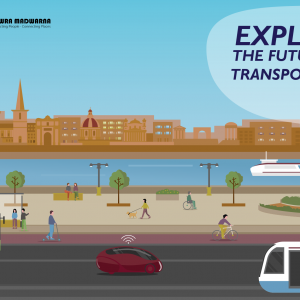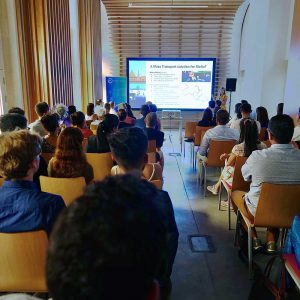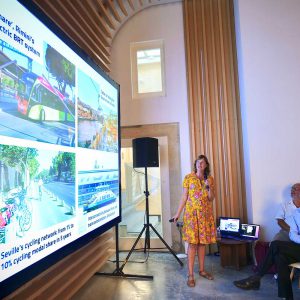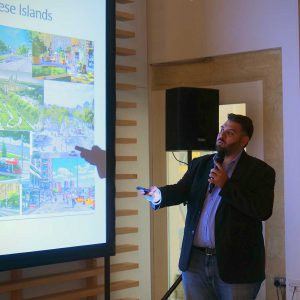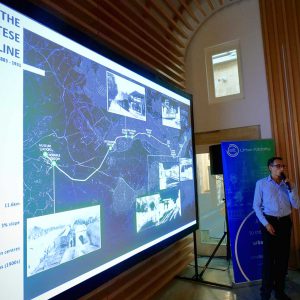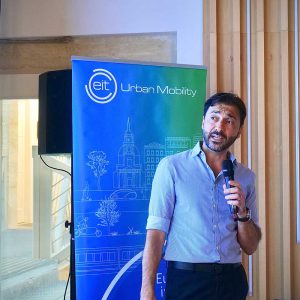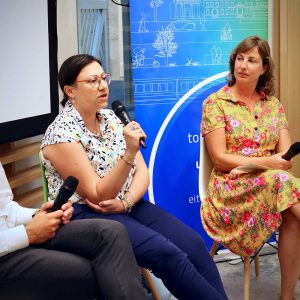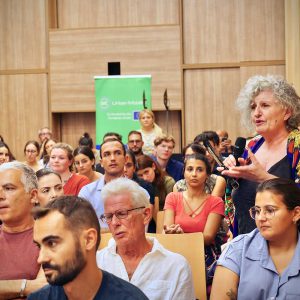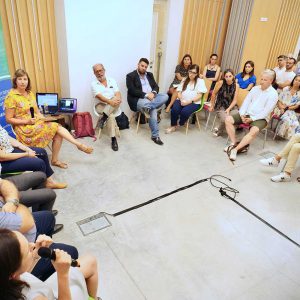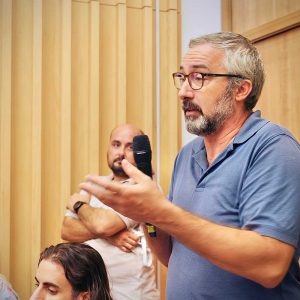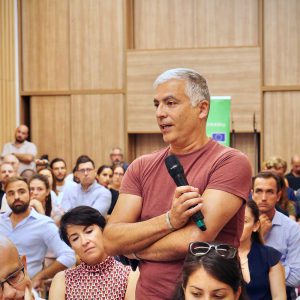Activities
The Future of Mass Transport in Malta – Symposium
Is the answer a metro, a tram, or the good old bus? On Thursday 15 September, on the eve of European Mobility Week 2022, the EIT Urban Mobility RIS Hub Malta and Dawra Madwarna organised a symposium to discuss the future of mass transport in Malta.
A full conference hall at the Valletta Design Cluster was introduced to the topic of mass transport by Dr Suzanne Maas. The 2021 National Household Travel Survey revealed that 85% of local trips are made by private car, and with 55 new cars being added to our roads daily, it is evident that the transport system in Malta is on a one-way road to ever-increasing traffic and parking issues. The need for an efficient mass transport system is clear, but what is the right solution for the Maltese context?
The symposium “Exploring the future of mass transport in Malta” sought to provide a space for an open, constructive and stimulating discussion on the future of mass transport in Malta, with a panel of experts and the audience weighing in, to compare and assess different solutions for a mass transport network in Malta. To inspire the audience, five pre-selected participants were invited to pitch their ideas for mass transport and improved public transport in Malta.
Architect Malcolm Cachia kicked off with his concept for a Hybrid Mass Rapid Transit system. He started his pitch by questioning what kind of city we want to live in: “do you want to be walking through car parks or through plazas?” His alternative to today’s congested streets full of private cars is a hybrid mass transit system, comprising 5 lines combining the best of underground metro and overground tram systems.
Second to pitch was Dr. Deborah Pizzuto who presented Malta Public Transport’s plan for a Bus Rapid Transit (BRT) system. A BRT is the mass transport system that is the closest to a conventional bus system as we have and can therefore be implemented rapidly and at a much lower cost than an underground mass transport solution, as it requires minimal infrastructure changes. Bus rapid transit systems feature dedicated lanes with right of way, with optimal busway alignment and intersection treatments to increase efficiency and comfort. Platform-level boarding and off-board fare collection make boarding and alighting very fast and efficient.
Architect and urban planner Steve Montebello’s Green Line project aims to connect the town centres of 8 localities along the old railway line by providing unobstructed paths for active mobility and public transport (BRT or tram). The former railway link is envisioned as a green corridor where trees and vegetation are used as landmarks and urban components to improve air quality, noise reduction and urban cooling, thus enabling people to use public space to relax.
The Alternative Grid of architect Daniel Scerri is a separate and segregated infrastructure network to provide a safe and efficient alternative for cyclists, pedestrians and kick-scooters. The idea is to create a secondary network that follows existing country lanes and abandoned paths and to interconnect them with bridges and tunnels to level off the hills and the current difficulties and dangers in using the existing primary road network. The average trip distance in Malta is around 5.5 kilometres, a distance that can be easily made by bicycle or on foot.
The final speaker, ICT specialist Dr. Godfrey Vella chose to approach the mobility challenge from an IT perspective to explore a national mass scale Demand Responsive Transport (DRT) system as the backbone of our public transport, going beyond the scope of existing operators in Malta. He envisions a national stem, made up of minivans, pick-up and drop-off points, that could bring one from A to B without changing modes of transport and not taking much longer than a private car take, and at a low cost handled by a central software system.
These inspiring ideas, their merits and drawbacks, and their potential role in the future of transport in Malta were then discussed with a group of local transport experts: Dr. Odette Lewis, Senior Lecturer, University of Malta (Faculty for the Built Environment), Dr. Therese Bajada, Lecturer, University of Malta (Institute for Climate Change and Sustainable Development), Mr. Konrad Pulé, General Manager, Malta Public Transport, and Ing. Karl Camilleri, Deputy Director, MCAST (Institute of Business Management and Commerce), moderated by Dr. Suzanne Maas.
Visions of a future transport system
Due to Malta’s small size and dense urbanisation, the question of space was raised. Mr. Konrad Pule, General Manager, Malta Public Transport explained that this issue is actually easy to resolve by removing on-street car parking. This could create plenty of space by converting car parks into plazas and public spaces for people and moving some of these parking spaces underground. However, as a car-centric culture, even the smallest changes to available parking areas are met with heavy opposition.
How can Malta come up to speed with the rest of Europe? Dr. Therese Bajada, Lecturer, University of Malta agreed that this is indeed the salient question and posited that political will is needed to drive change. However, it is not only the policies which are lacking, but that unfortunately public sentiment is very much against these changes; people are unaccepting of measures that would disincentivise private car use. We need to find a balance by making cleaner transport modes attractive to people, but we also need disincentives; today it is still too easy to go everywhere by car and find parking for free. Without a balance between carrots (incentives) and sticks (disincentives) the required modal shift will not happen, Mr. Pule added.
The need for political courage
The shift from private car use to mass transport, only happens in three ways: firstly, as a result of a big shock to the entire country that forces us into change, such as a war or a catastrophic event, secondly, as a result of top-down political direction guided by courageous decisions, and thirdly, public demand, through a bottom-up process. Unfortunately, since the 1930s, every consecutive government has shifted the onus of transport from public to private, removing systems such as the railway and focusing almost solely on building roads. It is very difficult to see change happening, until there is a strong reason for it – Ing. Karl Camilleri, Deputy Director, MCAST (Institute of Business Management and Commerce) posited.
We need politicians with vision and guts, who are willing to risk their political career to leave a legacy. Ing. Karl Camilleri thinks that we cannot just tell people that a shift to sustainable modes of transport is “good” and expect them to follow suit. Rather, you have to force people to make the shift.
Land use and transport planning need to go hand in hand
Architects and planners need to be the drivers of this change, as they are planning and designing our network. Changing the way we design our buildings and the spaces around them will make a big difference, Mr. Pule emphasised. This is indeed what we can see happening abroad, where whole neighbourhoods are planned to be car-free, following the concept of ‘transit-oriented development’ (TOD), making active and public transport the most accessible, convenient and safe way to travel, Dr. Suzanne Maas added.
What can be done in the short-term?
Buses are the backbone of our transport system, and they are the transport means which provides the best accessibility to destinations within urban areas when compared with other forms of public transport. Improving the bus service should be the focus in the short term. Even though improvements have been made, research is showing that timing still needs to be improved. Enforcement would be key to remove illegal parking which hinders bus movement. The National Transport Master Plan identifies the need for Public Transport Quality Corridors. There are stretches of bus routes which were identified where buses should be given priority. Currently, we have some stretches of bus lanes however these are not continuous, Dr. Lewis commented. Segregated lanes for cycling and facilitating walking should also be short term focuses. Since most trips locally are short distances, cycling and walking are ideal modes of transport and then buses can be used for longer distances. To make this happen however, introducing disincentives to reduce the convenience of using one’s private car, are essential, Dr. Bajada explained.
Multi-modality is the way forward
In a final round of comments, the panellists summarised their view on the future of (mass) transport in Malta. To proceed we need to improve on what we have. Mass transport is a need, an efficient means to move. A combination of what was discussed could be the way forward. A metro alone is not the solution for Malta. Instead, a multi-modal system, combining different transport modes is required. We need to keep on applying pressure, on transport operators (like Malta Public Transport) and on policy makers. Finally, it is important to consider transport equity: taking a human centric approach by considering the mobility needs of different demographic groups in the community, such as the elderly, people with a disability, young parents with pushchairs, youths and children, so as to create a transport system which works for all.
This event was organised by the EIT Urban Mobility RIS Hub Malta in collaboration with Dawra Madwarna. The EIT Urban Mobility RIS Hub Malta, supported by EIT Urban Mobility, an initiative of the European Institute for Innovation and Technology (EIT), aims to nurture sustainable visions for better local urban mobility on the Maltese islands. The Hub in Malta is led by Project Aegle Foundation (PAF, a non-profit promoting sustainable mobility), the Malta College of Arts, Science and Technology (MCAST) and the Valletta Design Cluster (VDC, part of the Valletta Cultural Agency). Dawra Madwarna is an organisation made up of professionals from different fields who work together, voluntarily, to propose better green public spaces for Malta. The aim at Dawra Madwarna is to contribute, be proactive, visionary and inspiring, to promote a new model for the design of urban open spaces.

